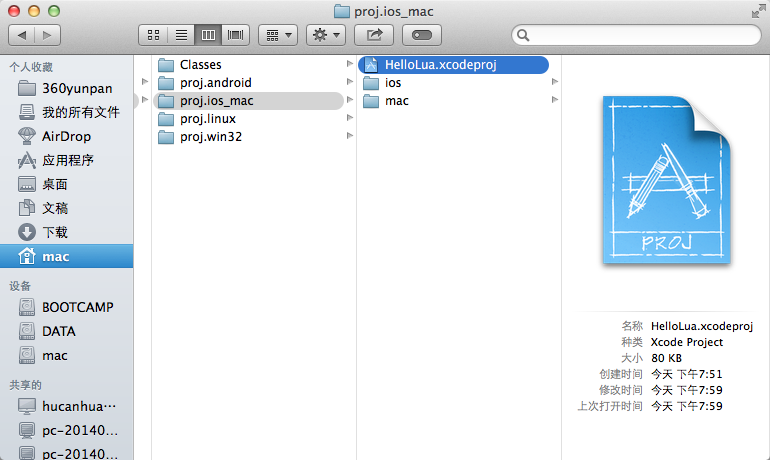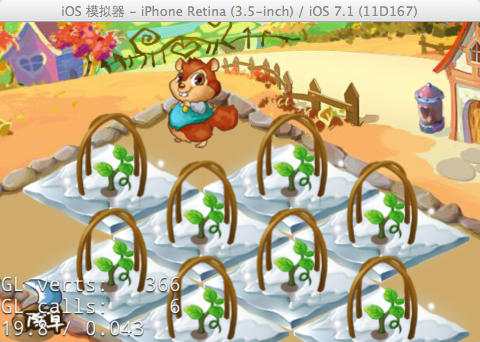Cocos2d-x-Lua演示样例项目HelloLua
本篇博客介绍Cocos2d-x中Lua的实例项目,就是使用Cocos2d-x创建的初始项目执行所呈现的农场,这里笔者取名为HelloLua。本篇博客会具体在代码中解析Cocos2d-x 3.1.1创建的Lua项目中实例,一些API的使用。
注:本演示样例项目在Mac系统下创建
首先我们来创建一个Cocos2d-x Lua项目,在命令敲入相似以下命令
cocos new HelloLua -p com.wwj.hellolua -l lua -d ~/Cocos2dxProj
这样我们就在Cocos2dxProj文件夹下创建了一个名叫HelloLua的Lua项目
进入我们runtime-src文件夹下打开proj.ios_mac文件夹。双击使用Xcode打开我们的项目:
使用Xcode对我们的Lua项目进行编译并执行,就会呈现一个以下效果的演示样例游戏:
看完效果图之后,来看看我们XCode里面的项目文件结构,例如以下图:
以上画圈的有main.cpp、AppDelegate.h、AppDelegate.cpp、main.lua、hello2.lua
我们以下一个一个来看:
首先来看main.cpp文件,这个文件就是我们程序的入口文件,程序的执行时从这里開始的
》》main.cpp
- #include "AppDelegate.h"
- #include "cocos2d.h"
-
- USING_NS_CC;
-
- int main(int argc, char *argv[])
- {
- AppDelegate app;
- return Application::getInstance()->run();
- }
以上代码我们能够看到,在main.cpp里,通过#include引入了两个头文件,一个是AppDelegate.h、一个是cocos2d.h。
定义了我们程序的入口方法main,通过执行Application::getInstance()->run()方法来执行我们的程序。
>>>AppDelegate.h
- #ifndef __APP_DELEGATE_H__
- #define __APP_DELEGATE_H__
-
- #include "cocos2d.h"
-
- /**
- @brief The cocos2d Application.
- The reason for implement as private inheritance is to hide some interface call by Director.
- */
- class AppDelegate : private cocos2d::Application
- {
- public:
- AppDelegate();
- virtual ~AppDelegate();
-
- /**
- @brief Implement Director and Scene init code here.
- @return true Initialize success, app continue.
- @return false Initialize failed, app terminate.
- */
- virtual bool applicationDidFinishLaunching();
-
- /**
- @brief The function be called when the application enter background
- @param the pointer of the application
- */
- virtual void applicationDidEnterBackground();
-
- /**
- @brief The function be called when the application enter foreground
- @param the pointer of the application
- */
- virtual void applicationWillEnterForeground();
- };
-
- #endif // __APP_DELEGATE_H__
>>>AppDelegate.cpp
- #include "AppDelegate.h"
- #include "CCLuaEngine.h"
- #include "SimpleAudioEngine.h"
- #include "cocos2d.h"
-
- using namespace CocosDenshion;
-
- USING_NS_CC;
- using namespace std;
-
- AppDelegate::AppDelegate()
- {
- }
-
- AppDelegate::~AppDelegate()
- {
- SimpleAudioEngine::end();
- }
-
- bool AppDelegate::applicationDidFinishLaunching()
- {
- // initialize director 获得导演类实例
- auto director = Director::getInstance();
- // 获得OpenGL实例
- auto glview = director->getOpenGLView();
- if(!glview) {
- // 指定窗体大小
- glview = GLView::createWithRect("HelloLua", Rect(0,0,900,640));
- // 设置OpenGL视图
- director->setOpenGLView(glview);
- }
- // 设置分辨率大小为480*320
- glview->setDesignResolutionSize(480, 320, ResolutionPolicy::NO_BORDER);
-
- // turn on display FPS 打开帧频,屏幕左下角哪一串数据
- // 启用FPS 显示,当前 FPS 会在游戏的左下角显示。
FPS也就是屏幕每秒重绘的次数。即每秒帧速率。在游戏开发阶段。能够方便地确定游戏执行是否流畅。 director->setDisplayStats(true); // set FPS. the default value is 1.0/60 if you don't call this // 设置绘制间隔 director->setAnimationInterval(1.0 / 60); // 获得Lua引擎实例 auto engine = LuaEngine::getInstance(); // 设置脚本引擎 ScriptEngineManager::getInstance()->setScriptEngine(engine); // 执行main.lua脚本 if (engine->executeScriptFile("src/main.lua")) { return false; } return true; } // This function will be called when the app is inactive. When comes a phone call,it's be invoked too // 当应用程序将要进入后台时,会调用这种方法 void AppDelegate::applicationDidEnterBackground() { Director::getInstance()->stopAnimation(); SimpleAudioEngine::getInstance()->pauseBackgroundMusic(); } // this function will be called when the app is active again // 该方法与applicationDidEnterBackground() 成对出现。在应用程序回到前台时被调用 void AppDelegate::applicationWillEnterForeground() { Director::getInstance()->startAnimation(); SimpleAudioEngine::getInstance()->resumeBackgroundMusic(); }
我们在AppDelegate类其中能够找到执行我们Lua脚本的方法,以下来看一下main.lua这个文件,我们屏幕显示的逻辑实现全部在这个文件里能够看到:
>>>main.lua
require "Cocos2d"
require "Cocos2dConstants"
-- cclog
cclog = function(...)
print(string.format(...))
end
-- for CCLuaEngine traceback 输出绑定执行函数发生错误的信息
function __G__TRACKBACK__(msg)
cclog("----------------------------------------")
cclog("LUA ERROR: " .. tostring(msg) .. "\n")
cclog(debug.traceback())
cclog("----------------------------------------")
return msg
end
local function main()
collectgarbage("collect")
-- avoid memory leak 这是脚本回收參数,避免内存泄漏
collectgarbage("setpause", 100)
collectgarbage("setstepmul", 5000)
-- 追加资源的搜索顺序
cc.FileUtils:getInstance():addSearchResolutionsOrder("src");
cc.FileUtils:getInstance():addSearchResolutionsOrder("res");
local schedulerID = 0
--support debug 获取目标平台
local targetPlatform = cc.Application:getInstance():getTargetPlatform()
if (cc.PLATFORM_OS_IPHONE == targetPlatform) or (cc.PLATFORM_OS_IPAD == targetPlatform) or
(cc.PLATFORM_OS_ANDROID == targetPlatform) or (cc.PLATFORM_OS_WINDOWS == targetPlatform) or
(cc.PLATFORM_OS_MAC == targetPlatform) then
cclog("result is ")
--require('debugger')()
end
-- 相似c++的include,引入文件,会检查是否反复引入
require "hello2"
-- 调用外部函数,在hello2.lua中
cclog("result is " .. myadd(1, 1))
---------------
-- 获取可视区域
local visibleSize = cc.Director:getInstance():getVisibleSize()
-- 可视原点坐标 OpenGL坐标系,左下角为原点
local origin = cc.Director:getInstance():getVisibleOrigin()
-- add the moving dog 加入移动的小松鼠
local function creatDog()
-- 每一帧尺寸设置,local表示局部变量
local frameWidth = 105
local frameHeight = 95
-- create dog animate 载入动画资源并创建精灵帧
-- 载入精灵动画所在纹理
local textureDog = cc.Director:getInstance():getTextureCache():addImage("dog.png")
-- 设置第一帧帧区域
local rect = cc.rect(0, 0, frameWidth, frameHeight)
-- 创建第一帧精灵Frame
local frame0 = cc.SpriteFrame:createWithTexture(textureDog, rect)
-- 设置第二帧帧区域
rect = cc.rect(frameWidth, 0, frameWidth, frameHeight)
-- c创建第二帧精灵Frame
local frame1 = cc.SpriteFrame:createWithTexture(textureDog, rect)
-- 基于使用第一帧Frame创建Sprite对象
local spriteDog = cc.Sprite:createWithSpriteFrame(frame0)
spriteDog.isPaused = false
spriteDog:setPosition(origin.x, origin.y + visibleSize.height / 4 * 3)
--[[
local animFrames = CCArray:create()
animFrames:addObject(frame0)
animFrames:addObject(frame1)
]]--
-- 依据帧序列数组创建一个动画animation。帧间隔时间delay等于0.5秒
local animation = cc.Animation:createWithSpriteFrames({frame0,frame1}, 0.5)
-- 依据动画animation创建动作实例
local animate = cc.Animate:create(animation);
-- 松鼠精灵执行该动作
spriteDog:runAction(cc.RepeatForever:create(animate))
-- moving dog at every frame 用来更新松鼠的位置,后面会调用该函数
local function tick()
if spriteDog.isPaused then return end
local x, y = spriteDog:getPosition()
if x > origin.x + visibleSize.width then
x = origin.x
else
x = x + 1
end
spriteDog:setPositionX(x)
end
-- 生成一个scheule,每帧执行tick函数
schedulerID = cc.Director:getInstance():getScheduler():scheduleScriptFunc(tick, 0, false)
return spriteDog
end
-- create farm 创建地面的农场
local function createLayerFarm()
-- 创建一个新的Lyaer用作农场管理
local layerFarm = cc.Layer:create()
-- add in farm background 加入农场管理
local bg = cc.Sprite:create("farm.jpg")
bg:setPosition(origin.x + visibleSize.width / 2 + 80, origin.y + visibleSize.height / 2)
layerFarm:addChild(bg)
-- add land sprite 加入地面砖块
for i = 0, 3 do
for j = 0, 1 do
local spriteLand = cc.Sprite:create("land.png")、
-- 设定每一块砖块位置
spriteLand:setPosition(200 + j * 180 - i % 2 * 90, 10 + i * 95 / 2)
layerFarm:addChild(spriteLand)
end
end
-- add crop 加入庄稼,注意crop.png是多张图的合成贴图。所以仅仅取了里面的部分贴图
local frameCrop = cc.SpriteFrame:create("crop.png", cc.rect(0, 0, 105, 95))
for i = 0, 3 do
for j = 0, 1 do
local spriteCrop = cc.Sprite:createWithSpriteFrame(frameCrop);
spriteCrop:setPosition(10 + 200 + j * 180 - i % 2 * 90, 30 + 10 + i * 95 / 2)
layerFarm:addChild(spriteCrop)
end
end
-- add moving dog 调用上面的createDog()方面。创建一个移动的松鼠
local spriteDog = creatDog()
layerFarm:addChild(spriteDog)
-- handing touch events 手指触摸事件处理
local touchBeginPoint = nil
-- 手指点击開始
local function onTouchBegan(touch, event)
local location = touch:getLocation()
cclog("onTouchBegan: %0.2f, %0.2f", location.x, location.y)
touchBeginPoint = {x = location.x, y = location.y} -- 保存点击位置
spriteDog.isPaused = true -- 将松鼠暂停移动
-- CCTOUCHBEGAN event must return true
return true
end
-- 手指按住移动
local function onTouchMoved(touch, event)
local location = touch:getLocation()
cclog("onTouchMoved: %0.2f, %0.2f", location.x, location.y)
if touchBeginPoint then
-- 将整个农村层拖动。由于之前已经将农场里面全部对象加入layerFarm
local cx, cy = layerFarm:getPosition()
layerFarm:setPosition(cx + location.x - touchBeginPoint.x,
cy + location.y - touchBeginPoint.y)
touchBeginPoint = {x = location.x, y = location.y}
end
end
-- 手指离开
local function onTouchEnded(touch, event)
local location = touch:getLocation()
cclog("onTouchEnded: %0.2f, %0.2f", location.x, location.y)
touchBeginPoint = nil -- 点击位置数据清空
spriteDog.isPaused = false -- 恢复松鼠移动
end
-- 创建触摸事件监听器
local listener = cc.EventListenerTouchOneByOne:create()
-- 注冊touch事件
listener:registerScriptHandler(onTouchBegan,cc.Handler.EVENT_TOUCH_BEGAN )
listener:registerScriptHandler(onTouchMoved,cc.Handler.EVENT_TOUCH_MOVED )
listener:registerScriptHandler(onTouchEnded,cc.Handler.EVENT_TOUCH_ENDED )
local eventDispatcher = layerFarm:getEventDispatcher()
-- 加入场景图优先级事件监听
eventDispatcher:addEventListenerWithSceneGraphPriority(listener, layerFarm)
local function onNodeEvent(event)
if "exit" == event then
cc.Director:getInstance():getScheduler():unscheduleScriptEntry(schedulerID)
end
end
layerFarm:registerScriptHandler(onNodeEvent)
return layerFarm
end
-- create menu 创建界面菜单
local function createLayerMenu()
-- 创建一个新的Layer管理全部菜单
local layerMenu = cc.Layer:create()
local menuPopup, menuTools, effectID
-- 点击菜单回调函数
local function menuCallbackClosePopup()
-- stop test sound effect 关闭音效
cc.SimpleAudioEngine:getInstance():stopEffect(effectID)
menuPopup:setVisible(false) -- 隐藏菜单
end
-- 点击菜单回调函数
local function menuCallbackOpenPopup()
-- loop test sound effect 打开营销
local effectPath = cc.FileUtils:getInstance():fullPathForFilename("effect1.wav")
effectID = cc.SimpleAudioEngine:getInstance():playEffect(effectPath)
menuPopup:setVisible(true)
end
-- add a popup menu 创建弹出的菜单面板
local menuPopupItem = cc.MenuItemImage:create("menu2.png", "menu2.png")
menuPopupItem:setPosition(0, 0)
menuPopupItem:registerScriptTapHandler(menuCallbackClosePopup)
menuPopup = cc.Menu:create(menuPopupItem)
menuPopup:setPosition(origin.x + visibleSize.width / 2, origin.y + visibleSize.height / 2)
menuPopup:setVisible(false)
layerMenu:addChild(menuPopup)
-- add the left-bottom "tools" menu to invoke menuPopup
-- 加入左下角的工具button。用来弹出菜单面板
local menuToolsItem = cc.MenuItemImage:create("menu1.png", "menu1.png")
menuToolsItem:setPosition(0, 0)
-- 注冊点击回调地址
menuToolsItem:registerScriptTapHandler(menuCallbackOpenPopup)
menuTools = cc.Menu:create(menuToolsItem)
local itemWidth = menuToolsItem:getContentSize().width
local itemHeight = menuToolsItem:getContentSize().height
menuTools:setPosition(origin.x + itemWidth/2, origin.y + itemHeight/2)
layerMenu:addChild(menuTools)
return layerMenu
end
-- play background music, preload effect
-- uncomment below for the BlackBerry version
local bgMusicPath = nil
if (cc.PLATFORM_OS_IPHONE == targetPlatform) or (cc.PLATFORM_OS_IPAD == targetPlatform) then
bgMusicPath = cc.FileUtils:getInstance():fullPathForFilename("res/background.caf")
else
bgMusicPath = cc.FileUtils:getInstance():fullPathForFilename("res/background.mp3")
end
cc.SimpleAudioEngine:getInstance():playMusic(bgMusicPath, true)
local effectPath = cc.FileUtils:getInstance():fullPathForFilename("effect1.wav")
-- 预载入音效
cc.SimpleAudioEngine:getInstance():preloadEffect(effectPath)
-- run
local sceneGame = cc.Scene:create() -- 创建场景
sceneGame:addChild(createLayerFarm()) -- 将农场层加入场景
sceneGame:addChild(createLayerMenu()) -- 将菜单界面层加入场景
-- 推断是否有执行的场景
if cc.Director:getInstance():getRunningScene() then
cc.Director:getInstance():replaceScene(sceneGame) -- 替换场景
else
cc.Director:getInstance():runWithScene(sceneGame)
end
end
--[[
xpcall( 调用函数, 错误捕获函数 );
lua提供了xpcall来捕获异常
xpcall接受两个參数:调用函数、错误处理函数。
当发生错误时,Lua会在栈释放曾经调用错误处理函数,因此能够使用debug库收集错误相关信息。两个经常使用的debug处理函数:debug.debug和debug.traceback 前者给出Lua的提示符,你能够自己动手察看发生错误时的情况; 后者通过traceback创建很多其它的错误信息,也是控制台解释器用来构建错误信息的函数。 --]] local status, msg = xpcall(main, __G__TRACKBACK__) if not status then error(msg) end
这是Cocos2d-x 3.1.1所使用的代码,代码中的凝视已经非常具体了,笔者在这里就不多说,希望大家能认真阅读,跟笔者一起尽快入门Lua在Cocos2dx中的使用。






